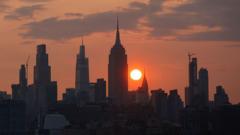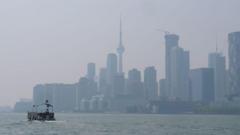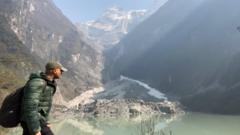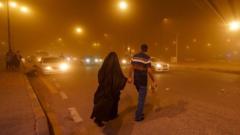Travelers in Delhi face disruptions as dense fog and hazardous air quality wreak havoc on transportation systems.
**Delhi's Dense Fog Disrupts Travel as Air Quality Deteriorates**
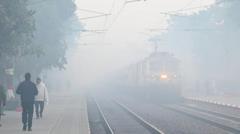
**Delhi's Dense Fog Disrupts Travel as Air Quality Deteriorates**
Severe weather conditions lead to significant delays in flights and trains, affecting thousands.
Dense fog combined with alarming air pollution levels has caused significant travel disruptions in Delhi, India's capital. This winter's recurring weather pattern resulted in visibility dropping to near zero in certain areas early Friday, severely affecting air and rail transport. Reports indicate that over 150 flights were delayed alongside numerous trains running behind schedule due to these adverse weather conditions.
Typically, during the winter months of December and January, northern India experiences a multifaceted air quality crisis, worsened by plummeting temperatures that trap pollutants near the surface. The air quality index in Delhi soared past 400 in multiple regions, a figure that exceeds the World Health Organization's safe limit by over 25 times, according to the state-run Safar website. In response, local authorities have reinstated pollution control measures, which include a halt on construction activities and transitioning school classes to online formats.
Visuals from Delhi and its neighboring areas captured a thick fog enveloping roads and agricultural lands, rendering structures almost invisible. The Delhi airport has released an advisory for passengers alerting them to potential flight disruptions due to low visibility. While operations continued, the advisory pointed out that non-CAT III compliant flights could be particularly susceptible to delays.
Flight-tracking platforms like flightradar24 reported delays of over 30 minutes for departures from Delhi Airport and about 20 minutes for arriving flights. Complaints from travelers regarding disorganization at the airport flooded social media. One user expressed frustration, noting the absence of boarding gate displays and confusion surrounding flight statuses. Additionally, the Indian Railways reported that 26 trains heading to the city were delayed due to fog.
Looking ahead, the weather department has forecast light rainfall over the weekend, which may improve visibility conditions in the region.
Typically, during the winter months of December and January, northern India experiences a multifaceted air quality crisis, worsened by plummeting temperatures that trap pollutants near the surface. The air quality index in Delhi soared past 400 in multiple regions, a figure that exceeds the World Health Organization's safe limit by over 25 times, according to the state-run Safar website. In response, local authorities have reinstated pollution control measures, which include a halt on construction activities and transitioning school classes to online formats.
Visuals from Delhi and its neighboring areas captured a thick fog enveloping roads and agricultural lands, rendering structures almost invisible. The Delhi airport has released an advisory for passengers alerting them to potential flight disruptions due to low visibility. While operations continued, the advisory pointed out that non-CAT III compliant flights could be particularly susceptible to delays.
Flight-tracking platforms like flightradar24 reported delays of over 30 minutes for departures from Delhi Airport and about 20 minutes for arriving flights. Complaints from travelers regarding disorganization at the airport flooded social media. One user expressed frustration, noting the absence of boarding gate displays and confusion surrounding flight statuses. Additionally, the Indian Railways reported that 26 trains heading to the city were delayed due to fog.
Looking ahead, the weather department has forecast light rainfall over the weekend, which may improve visibility conditions in the region.


